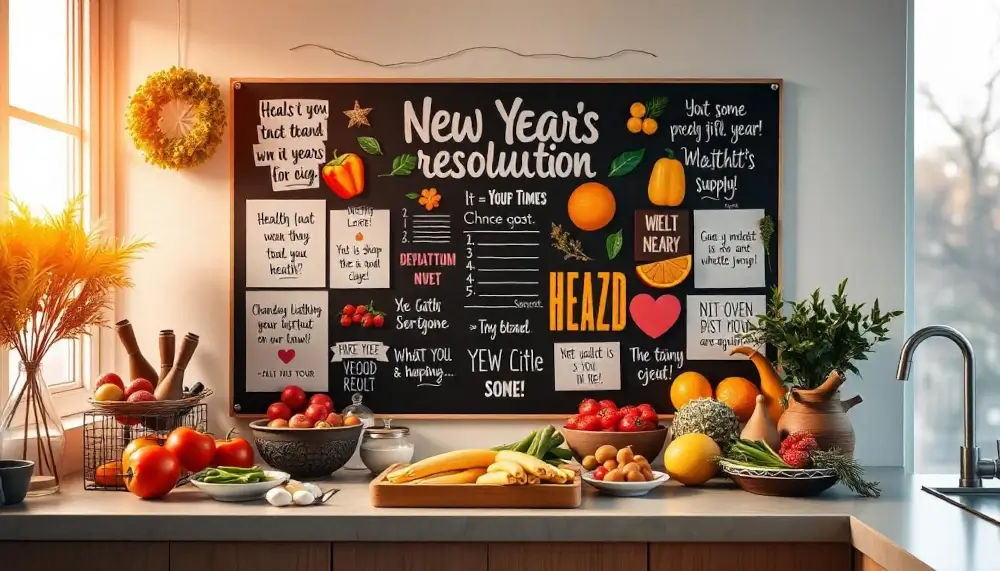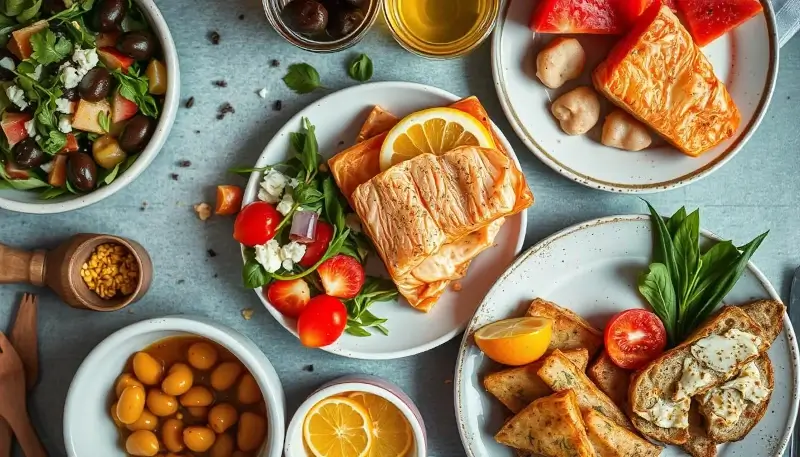
It’s January 1st. Your fridge is stocked with greens, your gym membership is freshly renewed, and you’re radiating with determination. Fast forward to February, and the greens are wilted, your gym shoes are gathering dust, and that initial enthusiasm? Poof—gone. Sound familiar?
You’re not alone. Studies show that nearly 80% of New Year’s resolutions fail by February. The reasons? Unrealistic goals, lack of planning, and—let’s face it—life just getting in the way. But here’s the good news: it doesn’t have to be this way.
What if I told you there’s a way to make your goals stick? To create real, lasting habits without the overwhelm? This isn’t about perfection; it’s about progress. In this article, we’re diving into the best diet plans, practical tips to stick with them, and strategies to make healthy eating a part of your everyday life—no fad diets or impossible rules required.
So grab a cup of tea and let’s make this the year you finally crack the code to lasting success. Because this time, you’ve got the tools—and the plan—to make it happen.
Why Most New Year’s Resolutions Fail by February – and How to Succeed

The Resolution Trap: Where It All Goes Wrong
Every January, millions of people declare bold intentions to transform their lives. Eat healthier. Exercise daily. Finally lose those stubborn pounds. Yet, despite their best efforts, most resolutions fizzle out by mid-February. Why?
The problem lies in how we approach resolutions:
- Unrealistic expectations: Many people aim for perfection instead of progress, setting goals like “never eat sugar again” or “work out every single day.”
- All-or-nothing mindset: One slip—a missed gym day or an indulgent dessert—leads to feelings of failure and giving up entirely.
- Lack of a plan: Without actionable steps or structure, even the most enthusiastic resolutions are tough to sustain.
Turning Resolutions Into Results
Here’s the truth: lasting change doesn’t come from sweeping resolutions—it comes from small, consistent actions. Imagine building a house. You don’t start by putting on the roof; you lay one brick at a time. The same principle applies to your New Year’s goals.
To succeed, you need:
- Clear and realistic goals: Instead of saying, “I’ll lose 20 pounds,” aim for something measurable and achievable, like “I’ll incorporate one more vegetable into my meals daily.”
- A flexible mindset: Understand that progress isn’t linear. Celebrate the wins, but don’t let setbacks derail your efforts.
- A step-by-step plan: Break your resolution into manageable chunks. Focus on building habits rather than chasing results.
This Article Might Be Your Roadmap to Success
If you’re tired of starting over every year, you’re in the right place. In the sections ahead, you’ll discover:
- Diet plans that are sustainable and effective.
- Strategies to make healthy habits stick for good.
- Practical tips to stay motivated, even when life gets busy.
This year isn’t about quick fixes—it’s about creating a lifestyle you can thrive in. Let’s get started!
The Popular Diet Plans That Actually Work

1. Mediterranean Diet: A Lifestyle, Not Just a Diet
If there were an award for the “least diet-y diet,” the Mediterranean diet would win every time. Rooted in the traditional eating habits of countries like Greece and Italy, this plan focuses on whole, unprocessed foods and a balanced approach to eating.
Why it works:
- Rich in heart-healthy fats like olive oil and nuts.
- Packed with fresh fruits, vegetables, whole grains, and lean proteins like fish and chicken.
- Encourages a relaxed, mindful approach to meals—no calorie counting required.
Quick meal idea: A colorful Greek salad with tomatoes, cucumbers, olives, feta cheese, a drizzle of olive oil, and grilled chicken on the side.
2. High-Protein Diet Meals for Weight Loss
Protein is the MVP of any weight loss journey. It keeps you full, fuels muscle recovery, and helps maintain lean body mass. Popular among athletes and fitness enthusiasts, a high-protein diet is a versatile and effective way to shed pounds without constant hunger pangs.
Why it works:
- Reduces cravings by keeping you fuller for longer.
- Supports fat loss while preserving muscle mass.
- Easy to adapt: just include protein in every meal and snack.
Quick meal idea: A protein-packed dinner of grilled salmon with steamed broccoli and quinoa.
3. Low-Calorie Foods That Keep You Full
Not all calories are created equal. Some foods, like leafy greens and lean proteins, provide high satiety without a hefty calorie count. Incorporating these low-calorie, nutrient-dense options can make it easier to maintain a calorie deficit without feeling deprived.
Why it works:
- Helps you lose weight without feeling constantly hungry.
- Easy to pair with other diets like Mediterranean or high-protein plans.
Quick snack idea: Sliced cucumbers with hummus or a hard-boiled egg sprinkled with paprika.
4. Meal Planning for a Balanced Diet
Meal planning is like the GPS of healthy eating—it gives you direction and makes the journey smoother. Instead of scrambling for last-minute meals (hello, takeout), meal prep ensures you always have something nutritious on hand.
Why it works:
- Saves time and reduces decision fatigue.
- Keeps you on track, even on busy days.
- Helps avoid unhealthy impulse choices.
Quick tip: Dedicate Sundays to prepping ingredients like grilled chicken, roasted vegetables, and quinoa. Mix and match these during the week for quick, healthy meals.
These diets work not because they’re restrictive but because they’re sustainable. But choosing a diet is only half the battle. The real challenge is sticking with it. Let’s explore how you can turn these plans into lifelong habits in the next section.
How to Make Your New Diet a Habit That Sticks

Changing your eating habits can feel like an uphill battle, but the good news is that small, consistent actions can make all the difference. It’s not about sheer willpower; it’s about setting yourself up for success.
Start Small and Set Realistic Goals
One of the biggest reasons people abandon diets is trying to change too much, too fast. The key? Start small.
- Example: Instead of cutting out sugar completely, start by swapping your afternoon soda for sparkling water with a splash of lime.
- Focus on one change at a time. Once it becomes a habit, layer on another small change.
Build a Routine with Meal Prep
Meal prep isn’t just for fitness enthusiasts—it’s a lifesaver for anyone trying to stick to a healthy diet.
- Dedicate a few hours on the weekend to chopping vegetables, grilling proteins, or prepping grains like quinoa.
- Store your meals in containers for grab-and-go lunches and dinners during the week.
Pro Tip: Use versatile ingredients. For example, grilled chicken can top salads, fill wraps, or be added to a stir-fry.
Keep It Interesting: Healthy Meals for Dinner Without the Boredom
Let’s face it—no one wants to eat the same bland chicken and broccoli every night. Experimenting with flavors and cuisines can keep your diet exciting.
- Try new herbs and spices: Curry powder, smoked paprika, or za’atar can transform a basic dish into something exotic.
- Rotate cuisines: One night Italian (pasta with zucchini noodles), the next Mexican (black bean and avocado tacos).
Quick Tip: Follow this blog or YouTube chefs for inspiration.
Don’t Let Setbacks Derail You
Life happens. Maybe you missed meal prep Sunday or gave in to a late-night pizza craving. That’s okay.
- Acknowledge it, forgive yourself, and move on.
- Instead of aiming for perfection, focus on consistency. A single “off day” doesn’t cancel out weeks of progress.
Mindset Shift: Treat your diet like a bank account. A single splurge doesn’t bankrupt you—what matters is your overall balance.
Now that you know how to turn healthy eating into a habit, it’s time to talk about staying motivated. In the next section, we’ll explore strategies to keep your energy and enthusiasm alive, even when the initial excitement wears off.
New Year, New Habits: Strategies to Stay Motivated

Starting a diet or new eating plan is one thing—sticking with it is another. Motivation often fades, especially when progress feels slow or life gets busy. But with the right strategies, you can keep the fire alive and stay on track.
Celebrate Progress, Not Perfection
If you’re waiting for the perfect week of flawless eating, you might be setting yourself up for disappointment. Instead, celebrate the small wins.
Examples of wins to celebrate:
- Cooking at home three nights in a row.
- Packing a healthy lunch for work.
- Choosing a piece of fruit over a candy bar.
Pro Tip: Keep a journal or app to track your wins and reflect on how far you’ve come.
Find Your “Why”
When motivation fades, reconnecting with your purpose can help you push through. Ask yourself:
- Why do I want to eat healthier? Is it to feel more energized? To set an example for my family? To improve my overall health?
- Write your “why” somewhere visible—on your fridge, your phone wallpaper, or your planner.
Mindset Tip: Remember, your “why” should be deeply personal and meaningful to you—not something society says you should do.
Surround Yourself with Support
The people you surround yourself with can make or break your motivation. Seek out a supportive community.
Ideas for finding support:
- Join a Facebook group or online forum for people with similar goals.
- Share your progress with a friend or family member who can cheer you on.
- Consider working with a nutrition coach or trainer for guidance.
Pro Tip: Avoid toxic diet culture spaces that focus on guilt or shame. Look for positivity and encouragement.
Make It Fun
Who says healthy eating has to be boring? Turn your journey into something enjoyable.
- Try cooking challenges: Explore a new recipe or ingredient each week.
- Take progress pictures—not just of your body, but your colorful meals and creative snacks.
- Reward yourself (non-food rewards) for milestones, like new workout gear or a self-care day.
With these strategies, staying motivated becomes less about willpower and more about creating an environment that supports your goals. Now, let’s address a common hurdle: snacking. If you’re tired of reaching for chips and cookies, I’ve got a solution that will make snacking both delicious and healthy.
Say Goodbye to Unhealthy Snacking – Grab 15 Healthy Snack Recipes!

Snacking can be your best friend or your worst enemy when it comes to sticking with a healthy diet. The problem? Most snacks are packed with sugar, empty calories, and unhealthy fats that sabotage your progress. But what if snacking could help you reach your goals instead of holding you back?
The Problem with Most Snacks
Let’s be honest: convenience often wins when hunger strikes. Chips, cookies, and candy bars are everywhere, but they’re also the culprits behind those stubborn extra pounds. These snacks spike your blood sugar, leaving you feeling hungrier just a few hours later.
Healthy Snacking Made Simple
The solution? Snack smarter, not harder. Healthy snacks can be just as satisfying as their unhealthy counterparts—you just need the right recipes. That’s where my 15 Healthy Snack Recipes ebook comes in.
Here’s what you’ll get in this free guide:
- Quick and easy recipes: No complicated ingredients or hours in the kitchen.
- Balanced nutrition: Snacks packed with protein, fiber, and good fats to keep you full.
- Delicious variety: From savory to sweet, you’ll never feel deprived.
Why These Snacks Work
Each recipe in the ebook is designed to:
- Satisfy your cravings without the guilt.
- Help you stay energized and focused throughout the day.
- Support your weight loss and health goals without feeling restrictive.
Examples from the guide:
- Dark chocolate and almonds.
- Roasted chickpeas with paprika.
- Cantaloupe slices wrapped in prosciutto
Ready to Snack Smarter? Download the Guide Now!
Healthy eating doesn’t mean giving up snacking—it means choosing snacks that fuel your body and your goals. With these 15 recipes, you’ll have a go-to list of options that are quick, delicious, and totally guilt-free.
Click here to download your free ebook now!
With the right snacks in your arsenal, staying on track becomes a whole lot easier. Now, let’s wrap things up and set you on the path to success with some final words of encouragement.
Conclusion: Embrace the Journey, Not Just the Destination
Change doesn’t happen overnight, and that’s okay. Building healthy habits, sticking to a diet, and transforming your lifestyle is a journey—a series of small, meaningful steps that add up over time.
This year, let go of the idea of perfection. Instead, focus on progress. Whether it’s experimenting with a Mediterranean meal, meal prepping for the week, or swapping out unhealthy snacks for smarter options, every choice you make brings you closer to your goals.
Remember, it’s not about following a rigid plan or achieving quick fixes. It’s about creating a sustainable way of living that you enjoy and can stick to in the long term.






